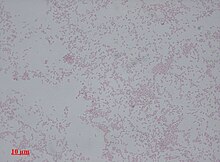
Back متقلبة رائعة Arabic متقلبه رائعه ARZ Proteus mirabilis Catalan Proteus mirabilis German Proteus mirabilis Spanish پروتئوس میرابیلیس Persian Proteus mirabilis French Proteus mirabilis Galician Proteus mirabilis Italian Proteus mirabilis Macedonian
| Proteus mirabilis | |
|---|---|

| |
| P. mirabilis on an XLD agar plate. | |
| Scientific classification | |
| Domain: | Bacteria |
| Phylum: | Pseudomonadota |
| Class: | Gammaproteobacteria |
| Order: | Enterobacterales |
| Family: | Enterobacteriaceae |
| Genus: | Proteus |
| Species: | P. mirabilis
|
| Binomial name | |
| Proteus mirabilis Hauser, 1885
| |

Proteus mirabilis is a Gram-negative, facultatively anaerobic, rod-shaped bacterium. It shows swarming motility and urease activity. P. mirabilis causes 90% of all Proteus infections in humans. It is widely distributed in soil and water.[1] Proteus mirabilis can migrate across the surface of solid media or devices using a type of cooperative group motility called swarming. Proteus mirabilis is most frequently associated with infections of the urinary tract, especially in complicated or catheter-associated urinary tract infections.[2]
- ^ "Proteus mirabilis". BioMedHTC. Archived from the original on 26 September 2009.
Bacteria of the species Proteus mirabilis are widely distributed in soil and water in the natural environment. In humans, Proteus is found as part of the normal flora of the gut....from
- ^ Chen CY, Chen YH, Lu PL, Lin WR, Chen TC, Lin CY (June 2012). "Proteus mirabilis urinary tract infection and bacteremia: risk factors, clinical presentation, and outcomes". Journal of Microbiology, Immunology, and Infection = Wei Mian Yu Gan Ran Za Zhi. 45 (3): 228–236. doi:10.1016/j.jmii.2011.11.007. PMID 22572004.